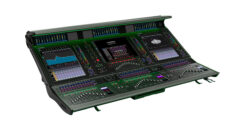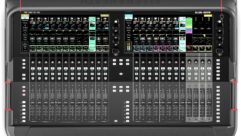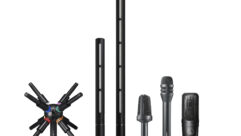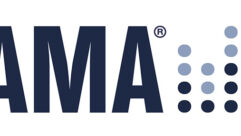Whether for the return of live sound, or the needs of installed sound applications, mixers and audio continue to be the heart of a range of systems and the glue. Here’s a look at some of the current options out there for selected consoles, mic mixers, and audio processors.
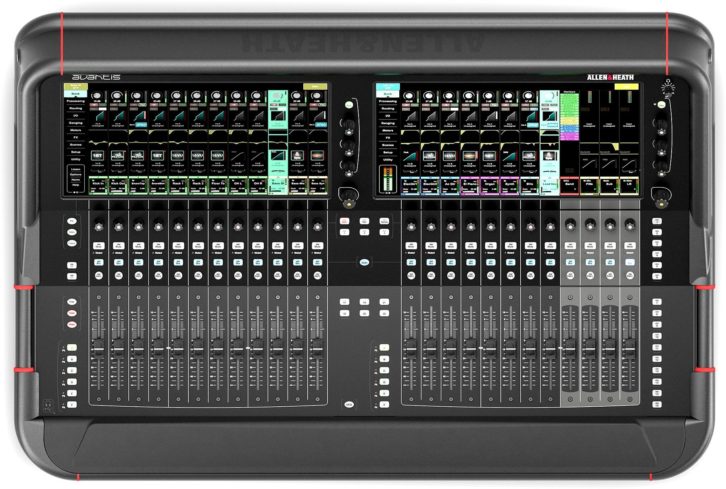 Allen & Heath’s 96kHz digital mixer, Avantis, is the third to be based on the company’s XCVI FPGA engine. Avantis is a 64-channel/42 configurable bus console, with twin Full HD touchscreens, extensive I/O options and processing from the company’s flagship dLive mixing system. The console’s Continuity UI supports gains and pans on the rotaries; a softkey switches to EQ or dynamics across the whole strip; and a configurable EasyGrab tab on each screen allows easy access control of aux sends, EQ, compressor and FX. While many users will choose to pair Avantis with the 48 in / 16 out GX4816 audio expander, Avantis is part of Allen & Heath’s Everything I/O ecosystem, which means it can be connected to a wide range of audio expander hardware, as well as the company’s ME Personal Mixers and IP hardware remote controllers. For local I/O, Avantis has 12 XLR analogue inputs, 12 XLR analogue outputs, plus AES (Stereo In, 2x Stereo Out). Two additional I/O Ports allow Avantis to use the full range of dLive option cards, including Dante (64×64 and 128×128), Waves, gigaACE, MADI and more.
Allen & Heath’s 96kHz digital mixer, Avantis, is the third to be based on the company’s XCVI FPGA engine. Avantis is a 64-channel/42 configurable bus console, with twin Full HD touchscreens, extensive I/O options and processing from the company’s flagship dLive mixing system. The console’s Continuity UI supports gains and pans on the rotaries; a softkey switches to EQ or dynamics across the whole strip; and a configurable EasyGrab tab on each screen allows easy access control of aux sends, EQ, compressor and FX. While many users will choose to pair Avantis with the 48 in / 16 out GX4816 audio expander, Avantis is part of Allen & Heath’s Everything I/O ecosystem, which means it can be connected to a wide range of audio expander hardware, as well as the company’s ME Personal Mixers and IP hardware remote controllers. For local I/O, Avantis has 12 XLR analogue inputs, 12 XLR analogue outputs, plus AES (Stereo In, 2x Stereo Out). Two additional I/O Ports allow Avantis to use the full range of dLive option cards, including Dante (64×64 and 128×128), Waves, gigaACE, MADI and more.
 The AMX Alero ALR-AEC-8 is a dedicated microphone mixer for up to eight microphones used for conferencing apps such as Lync or Skype in medium to large meeting rooms. It also supports VTC and audio conferencing systems. A USB audio output enables the Alero ALR-AEC-8 to be a microphone expansion unit for Enzo or PC-Based web conferencing applications, while an onboard web configuration tool allows for simple setup and configuration for users of any experience level, with no PC software required. The active adjustment of audio levels and settings means great audio quality without users having to make manual adjustments. Additionally, acoustic echo cancellation helps eliminate echo feedback during web and audio conferences.
The AMX Alero ALR-AEC-8 is a dedicated microphone mixer for up to eight microphones used for conferencing apps such as Lync or Skype in medium to large meeting rooms. It also supports VTC and audio conferencing systems. A USB audio output enables the Alero ALR-AEC-8 to be a microphone expansion unit for Enzo or PC-Based web conferencing applications, while an onboard web configuration tool allows for simple setup and configuration for users of any experience level, with no PC software required. The active adjustment of audio levels and settings means great audio quality without users having to make manual adjustments. Additionally, acoustic echo cancellation helps eliminate echo feedback during web and audio conferences.
 Ashly Audio’s mXa-1502 Mixer Amp MVP simplfies multi-zone audio. It provides four zones of mixing and DSP, plus 2 x 150W of power and programmable mic preamplifiers. The new mXa-1502 also incorporates DSP functions on all input and output channels and can be accessed and controlled via any browser-enabled device as well as the network using intuitive Ashly software. It also provides multi-zone music distribution, paging, sound-masking and automatic mixing for a wide range of environments including house of worship, education, business, and live performance. Its GUI doesn’t require extensive tutorials or workshops to master, allowing both integrators and end users to navigate using any browser-enabled device. Further, troubleshooting and reconfiguring can take place over the network, delivering a reduction in onsite technical support and a quicker return to functionality.
Ashly Audio’s mXa-1502 Mixer Amp MVP simplfies multi-zone audio. It provides four zones of mixing and DSP, plus 2 x 150W of power and programmable mic preamplifiers. The new mXa-1502 also incorporates DSP functions on all input and output channels and can be accessed and controlled via any browser-enabled device as well as the network using intuitive Ashly software. It also provides multi-zone music distribution, paging, sound-masking and automatic mixing for a wide range of environments including house of worship, education, business, and live performance. Its GUI doesn’t require extensive tutorials or workshops to master, allowing both integrators and end users to navigate using any browser-enabled device. Further, troubleshooting and reconfiguring can take place over the network, delivering a reduction in onsite technical support and a quicker return to functionality.
 The Audio-Technica ATDM-0604 is a six-channel automatic mixer ideal for meetings, conferences, courtroom proceedings, and other applications involving the use of multiple microphones or other media inputs. AudioTechnica’s SmartMixer technology allows channels to be mixed automatically in gate or gain sharing mode, ensuring consistent, high-quality audio output from all inputs in a setup. Controls and LED indicators on the mixer’s front panel allow users to easily adjust input/output and gain levels; set and recall presets; turn on/off phantom power, low-cut filter, automatic mixing and acoustic echo cancellation; change IP configuration; and more. A full complement of digital signal processing is available for inputs and outputs, including parametric EQ, compressor, limiter, and feedback control. Control and monitoring tools are accessible locally on the front panel or via the Web Remote interface, which allows users to handle the adjustments from a Windows-based PC, Mac, iOS or Android device, plus make additional changes to settings.
The Audio-Technica ATDM-0604 is a six-channel automatic mixer ideal for meetings, conferences, courtroom proceedings, and other applications involving the use of multiple microphones or other media inputs. AudioTechnica’s SmartMixer technology allows channels to be mixed automatically in gate or gain sharing mode, ensuring consistent, high-quality audio output from all inputs in a setup. Controls and LED indicators on the mixer’s front panel allow users to easily adjust input/output and gain levels; set and recall presets; turn on/off phantom power, low-cut filter, automatic mixing and acoustic echo cancellation; change IP configuration; and more. A full complement of digital signal processing is available for inputs and outputs, including parametric EQ, compressor, limiter, and feedback control. Control and monitoring tools are accessible locally on the front panel or via the Web Remote interface, which allows users to handle the adjustments from a Windows-based PC, Mac, iOS or Android device, plus make additional changes to settings.
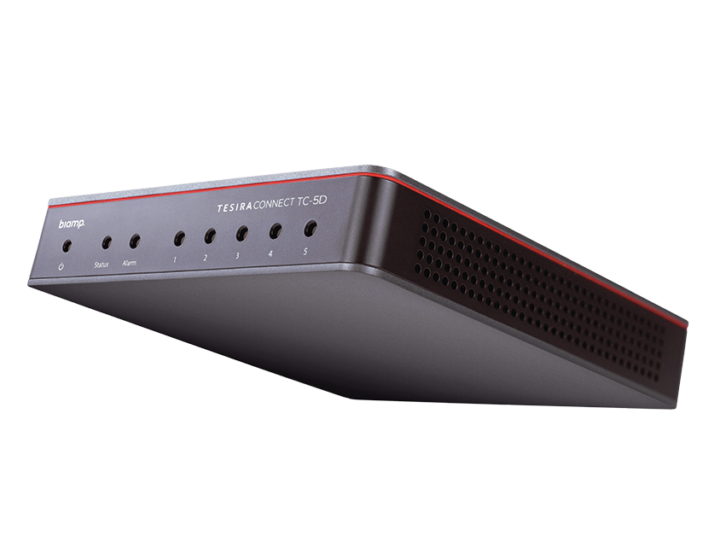 In February, Biamp announced the expansion of the TesiraCONNECT line to include the TesiraCONNECT TC-5D. The new dual network device allows designers to incorporate both AVB and Dante into their AV solutions.TesiraCONNECT TC-5D features the same plug and play simplicity of the recently introduced TC-5 connectivity appliance and adds the interoperability of Dante. With the TC-5D, designers and integrators can easily connect and power via PoE+ both Dante and Biamp AVB devices in the same system with no configuration required.
In February, Biamp announced the expansion of the TesiraCONNECT line to include the TesiraCONNECT TC-5D. The new dual network device allows designers to incorporate both AVB and Dante into their AV solutions.TesiraCONNECT TC-5D features the same plug and play simplicity of the recently introduced TC-5 connectivity appliance and adds the interoperability of Dante. With the TC-5D, designers and integrators can easily connect and power via PoE+ both Dante and Biamp AVB devices in the same system with no configuration required.
The new appliance allows connected Dante devices to be managed using Dante Domain Manager as well as configured in Dante Controller. Once installed, the TC-5D can be monitored and maintained using Biamp’s SageVue management platform like other Biamp products. Both TC-5D and the existing TC-5 model come with five network connections, four of which are PoE+-powered RJ-45 ports that support single-cable connectivity. An additional unpowered RJ-45 port is included to easily pass all signals back to a Tesira DSP such as the TesiraFORTÉ. For more complex installations requiring greater port capacity, integrators can daisy-chain up to four TesiraCONNECT devices. Both the TC-5 and TC-5D can mount under a table, in a cabinet, or behind a monitor The TesiraCONNECT TC-5D will be available in the third quarter of 2020.
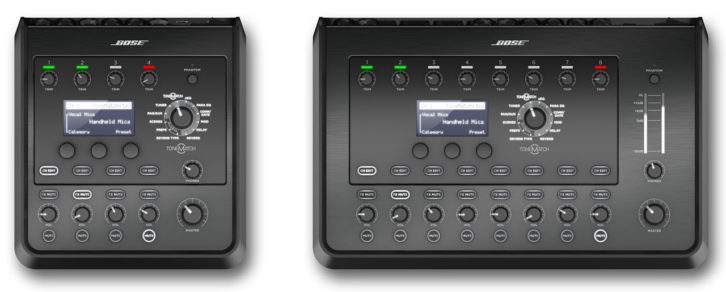 The latest additions to Bose’s ToneMatch audio engine series, the eight-channel T8S ToneMatch mixer and the four-channel T4S ToneMatch mixer, are compact and portable. Their enclosures have a protective, magnetically-coupled cover to protect controls and connectors. A chassis-bottom insert allows the use of standard mounting accessories to keep the mixers in reach during performances. The T8S is intuitive to operate, with illuminated, stage-friendly tactile controls, an easy-to-read display, and scene recall. ToneMatch processing provides presets with the DSP engine, including effects and Bose zEQ equalization. The T4S offers most of the same features as the T8S, but also includes dual ToneMatch links, designed to send digital audio to L1 Model 1S/II systems while receiving power on the same provided ToneMatch cable. Last fall, the company debuted a carrying case for the T4S and T8S ToneMatch mixers compatible with the T4S and T8S ToneMatch mixers. Each case features an integrated storage compartment, with the ability to carry the power supply, ToneMatch cable and additional equipment. The mXA1502 began shipping in later April.
The latest additions to Bose’s ToneMatch audio engine series, the eight-channel T8S ToneMatch mixer and the four-channel T4S ToneMatch mixer, are compact and portable. Their enclosures have a protective, magnetically-coupled cover to protect controls and connectors. A chassis-bottom insert allows the use of standard mounting accessories to keep the mixers in reach during performances. The T8S is intuitive to operate, with illuminated, stage-friendly tactile controls, an easy-to-read display, and scene recall. ToneMatch processing provides presets with the DSP engine, including effects and Bose zEQ equalization. The T4S offers most of the same features as the T8S, but also includes dual ToneMatch links, designed to send digital audio to L1 Model 1S/II systems while receiving power on the same provided ToneMatch cable. Last fall, the company debuted a carrying case for the T4S and T8S ToneMatch mixers compatible with the T4S and T8S ToneMatch mixers. Each case features an integrated storage compartment, with the ability to carry the power supply, ToneMatch cable and additional equipment. The mXA1502 began shipping in later April.
 The ClearOne CONVERGE Pro 2 48VTD includes VoIP, Telco, and Dante interfaces in a single CONVERGE Pro 2 unit. The 48VTD pairs well with ClearOne’s BMA CT and allows integrators to simplify system designs, increasing installation flexibility and reducing costs. The four-input CONVERGE Pro 2 48VTD can also lower costs when paired with our new P-Link-based BMA CT, allowing integrators to bring a low-cost Dante interface to the BMA CT. It functions the same as ClearOne’s existing V and T offerings providing a 10-Watt amplifier, four configurable mic/line audio inputs, and 8 configurable mic/ line outputs. Additionally, all models are Avaya, Cisco, and ShoreTel compliant, and support built-in USB audio, and builtin Skype for Business along with interfaces for VoIP, Telco, and Dante. The VTD series works with all existing CONVERGE Pro 2 units and all existing P-Link peripheral products. In April, ClearOne announced CONVERGENCE AV Network Manager, a unified AV network management platform to remotely monitor, control, audit and update ClearOne Pro products and services. A beta version was available to AV practitioners for their evaluation prior to this release. The new release provides efficient batch firmware updates on multiple audio and video devices at once. Including simultaneous support for multiple CONVERGE Pro 2 and CONVERGE Huddle systems.
The ClearOne CONVERGE Pro 2 48VTD includes VoIP, Telco, and Dante interfaces in a single CONVERGE Pro 2 unit. The 48VTD pairs well with ClearOne’s BMA CT and allows integrators to simplify system designs, increasing installation flexibility and reducing costs. The four-input CONVERGE Pro 2 48VTD can also lower costs when paired with our new P-Link-based BMA CT, allowing integrators to bring a low-cost Dante interface to the BMA CT. It functions the same as ClearOne’s existing V and T offerings providing a 10-Watt amplifier, four configurable mic/line audio inputs, and 8 configurable mic/ line outputs. Additionally, all models are Avaya, Cisco, and ShoreTel compliant, and support built-in USB audio, and builtin Skype for Business along with interfaces for VoIP, Telco, and Dante. The VTD series works with all existing CONVERGE Pro 2 units and all existing P-Link peripheral products. In April, ClearOne announced CONVERGENCE AV Network Manager, a unified AV network management platform to remotely monitor, control, audit and update ClearOne Pro products and services. A beta version was available to AV practitioners for their evaluation prior to this release. The new release provides efficient batch firmware updates on multiple audio and video devices at once. Including simultaneous support for multiple CONVERGE Pro 2 and CONVERGE Huddle systems.
The XD-16 and XD-28 digital mixers from Crest Audio are small format, 2U rackmount mixers available in either 16- or 28-channel frames. XD Series digital mixers offer optional Dante networking as well as a realtime remote control and monitoring from any Android, Windows, or iOS device. The range of configurations available enables use as a simple FoH mixer, a monitor mixer, a personal monitor mixer, or a combination of all three. An integrated WiFi module enables real-time control and monitoring of the mixer processing functions, either by acting as a WiFi router for direct connection of up to four external devices for remote control, or alternatively by connecting to an external WiFi network. The optional 4×4 Dante network module allows up to eight channels (4-in/4-out) of audio streaming over a Dante network, and also extends the physical inputs of the XD-16/XD-28 by four aux channels, and also adds four outputs. Control is provided via the Dante Controller application.
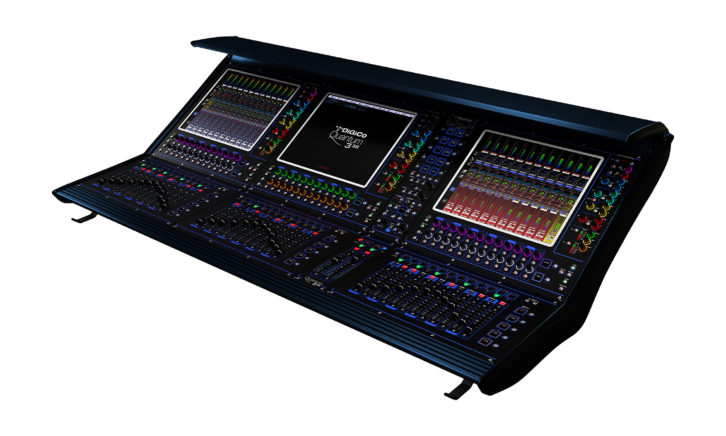 At NAMM, DiGiCo revealed its new generation of Quantum consoles, including the all-new Quantum 338. Quantum 338 claims a dramatic leap forward in power and connectivity in a smaller format console. Quantum 338 is based on seventh-generation FPGAs and includes 128 input channels with 64 busses and a 24 x 24 matrix, all with full channel processing. There is a new Dark Mode application and three 17-inch 1000 nit, high brightness, multitouch screens, allowing both the meter bridge and soft quick-select buttons to be displayed on each screen. There are also 70 individual TFT channel displays and the floating Quantum chassis features 38 x 100mm touch-sensitive faders laid out in three blocks of 12 fader banks, plus two dedicated user-assignable faders, each complete with high-resolution metering. “Ultimate Stadius” 32-bit ADC and DAC conversion are built into Quantum 338 as standard, alongside six single or three redundant MADI connections, dual DMI slots, and a built-in UB MADI USB recording interface. Mustard Processing channel strips, Spice Rack plugin-tyle native FPGA processing options, plus Nodal Processing and True Solo, which all launched last year for the Quantum 7, are also standard on the Quantum 338.
At NAMM, DiGiCo revealed its new generation of Quantum consoles, including the all-new Quantum 338. Quantum 338 claims a dramatic leap forward in power and connectivity in a smaller format console. Quantum 338 is based on seventh-generation FPGAs and includes 128 input channels with 64 busses and a 24 x 24 matrix, all with full channel processing. There is a new Dark Mode application and three 17-inch 1000 nit, high brightness, multitouch screens, allowing both the meter bridge and soft quick-select buttons to be displayed on each screen. There are also 70 individual TFT channel displays and the floating Quantum chassis features 38 x 100mm touch-sensitive faders laid out in three blocks of 12 fader banks, plus two dedicated user-assignable faders, each complete with high-resolution metering. “Ultimate Stadius” 32-bit ADC and DAC conversion are built into Quantum 338 as standard, alongside six single or three redundant MADI connections, dual DMI slots, and a built-in UB MADI USB recording interface. Mustard Processing channel strips, Spice Rack plugin-tyle native FPGA processing options, plus Nodal Processing and True Solo, which all launched last year for the Quantum 7, are also standard on the Quantum 338.
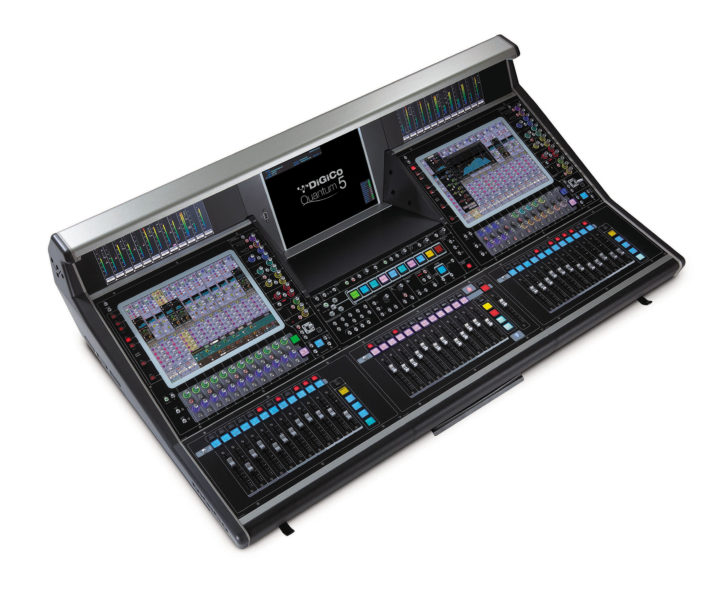 Previewed at NAMM for delivery later this year, DiGiCo Quantum 5 follows on from the flagship Quantum 7. As with Quantum 7, the Quantum 5 engine slots neatly into the existing SD5 frame and, with its 37 faders and three 15-inch full-color TFT touchscreens, provides Quantum processing features, power, and connectivity in both new and existing hardware. Quantum 5 expands the SD5 to over 450 channels of processing at 96kHz. It includes up to 256 input channels with up to 128 busses and a 36 x 36 matrix. The engine is also equipped with four redundant, or eight individual, MADI ports and two DMI slots (DiGiCo Multi-Channel Interface) for AoIP and other connectivity options from the complete family of DMI card options, plus a built-in Waves port and up to two Optocore loops. The popular Nodal Processing and True Solo features, are included, as well as 48 channels of Mustard processing and 12 Spice Rack processing slots, including Chili 6. Like everything in the Quantum range, Quantum 5 is developed with seventh generation FPGA devices.
Previewed at NAMM for delivery later this year, DiGiCo Quantum 5 follows on from the flagship Quantum 7. As with Quantum 7, the Quantum 5 engine slots neatly into the existing SD5 frame and, with its 37 faders and three 15-inch full-color TFT touchscreens, provides Quantum processing features, power, and connectivity in both new and existing hardware. Quantum 5 expands the SD5 to over 450 channels of processing at 96kHz. It includes up to 256 input channels with up to 128 busses and a 36 x 36 matrix. The engine is also equipped with four redundant, or eight individual, MADI ports and two DMI slots (DiGiCo Multi-Channel Interface) for AoIP and other connectivity options from the complete family of DMI card options, plus a built-in Waves port and up to two Optocore loops. The popular Nodal Processing and True Solo features, are included, as well as 48 channels of Mustard processing and 12 Spice Rack processing slots, including Chili 6. Like everything in the Quantum range, Quantum 5 is developed with seventh generation FPGA devices.
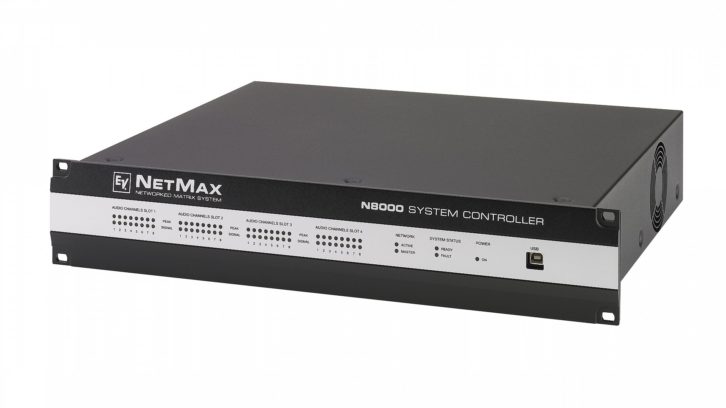 The Electro-Voice N8000 NetMax 300 MIPS digital matrix controller delivers full IRIS-Net supervision, control, and scheduling along with up to 32 input channels, extensive DSP, and CobraNet audio and control connections. It offers support for ethernet, RS-232, USB, and CAN, and Dante audio networking options are available. Four slots with 8-channel audio modules form the foundation for flexible customization, and each slot can house input or output cards. It includes internal 48-bit processing, and the auto-compiling DSP engine has ultra-low fixed latency. One time or regularly scheduled events can be arranged and reactions to certain events or system states can be configured. Any system problems can be detected automatically and can be displayed on the PC screen or transmitted to external sites.
The Electro-Voice N8000 NetMax 300 MIPS digital matrix controller delivers full IRIS-Net supervision, control, and scheduling along with up to 32 input channels, extensive DSP, and CobraNet audio and control connections. It offers support for ethernet, RS-232, USB, and CAN, and Dante audio networking options are available. Four slots with 8-channel audio modules form the foundation for flexible customization, and each slot can house input or output cards. It includes internal 48-bit processing, and the auto-compiling DSP engine has ultra-low fixed latency. One time or regularly scheduled events can be arranged and reactions to certain events or system states can be configured. Any system problems can be detected automatically and can be displayed on the PC screen or transmitted to external sites.
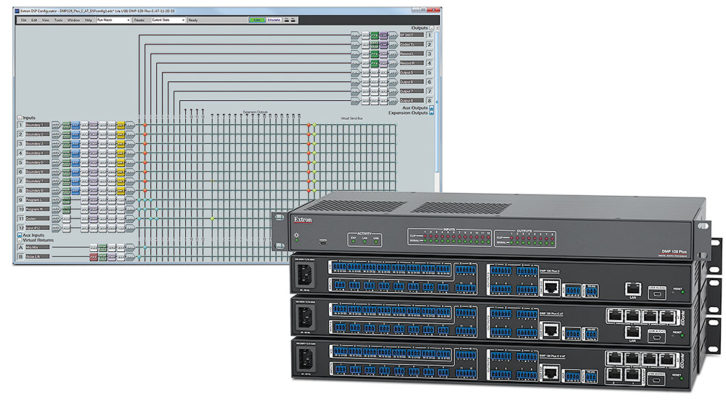 Extron has released firmware version 1.02 for the DMP 128 Plus digital matrix processors. With this free firmware update, the four DMP 128 Plus C models support up to 12 independent channels of high-performance AEC, up from 8 channels, with no hardware changes. The three DMP 128 Plus AT models now also support Dante Domain Manager, network management software, from Audinate. DDM enables user authentication, rolebased security, and seamless expansion of Dante systems over any network infrastructure. This firmware update adds compatibility with the VoIP MS cloud-based VoIP system for the DMP 128 Plus V models, continuing our commitment to the widest possible VoIP compatibility. Finally, the ability to convert project files between DMP 128 Plus types has been added with this firmware and DSP Configurator Software version 2.20.
Extron has released firmware version 1.02 for the DMP 128 Plus digital matrix processors. With this free firmware update, the four DMP 128 Plus C models support up to 12 independent channels of high-performance AEC, up from 8 channels, with no hardware changes. The three DMP 128 Plus AT models now also support Dante Domain Manager, network management software, from Audinate. DDM enables user authentication, rolebased security, and seamless expansion of Dante systems over any network infrastructure. This firmware update adds compatibility with the VoIP MS cloud-based VoIP system for the DMP 128 Plus V models, continuing our commitment to the widest possible VoIP compatibility. Finally, the ability to convert project files between DMP 128 Plus types has been added with this firmware and DSP Configurator Software version 2.20.
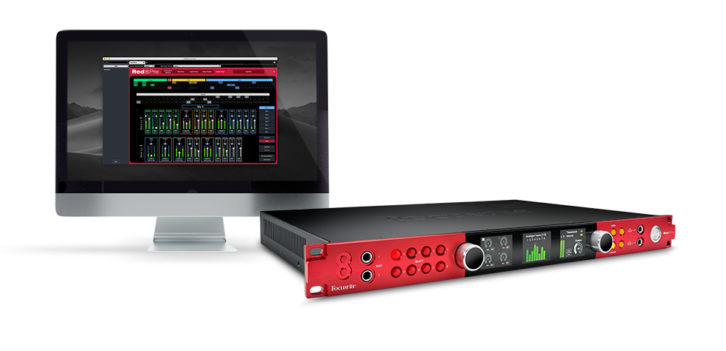 Focusrite has released RedNet Control 2.3, a free update that unifies RedNet Control with configuration, status monitoring, metering, and extended operational control of the Red 4Pre, Red 8Pre, and Red 16Line, Focusrite’s range of audio interfaces offering up to 64-in/64-out Thunderbolt I/O with Pro Tools HD and Dante network audio connectivity. Focusrite RedNet Control’s “Device View” features a graphical representation of each device on the local network, giving critical feedback such as signal metering, clock status, power supply state, and primary/ secondary network connection state. RedNet Control is customizable, which allows for several users on the same network to have completely different views. RedNet Control now also provides parameter control, which includes clock source selection, sample rate converter configuration, and reference level setup.
Focusrite has released RedNet Control 2.3, a free update that unifies RedNet Control with configuration, status monitoring, metering, and extended operational control of the Red 4Pre, Red 8Pre, and Red 16Line, Focusrite’s range of audio interfaces offering up to 64-in/64-out Thunderbolt I/O with Pro Tools HD and Dante network audio connectivity. Focusrite RedNet Control’s “Device View” features a graphical representation of each device on the local network, giving critical feedback such as signal metering, clock status, power supply state, and primary/ secondary network connection state. RedNet Control is customizable, which allows for several users on the same network to have completely different views. RedNet Control now also provides parameter control, which includes clock source selection, sample rate converter configuration, and reference level setup.
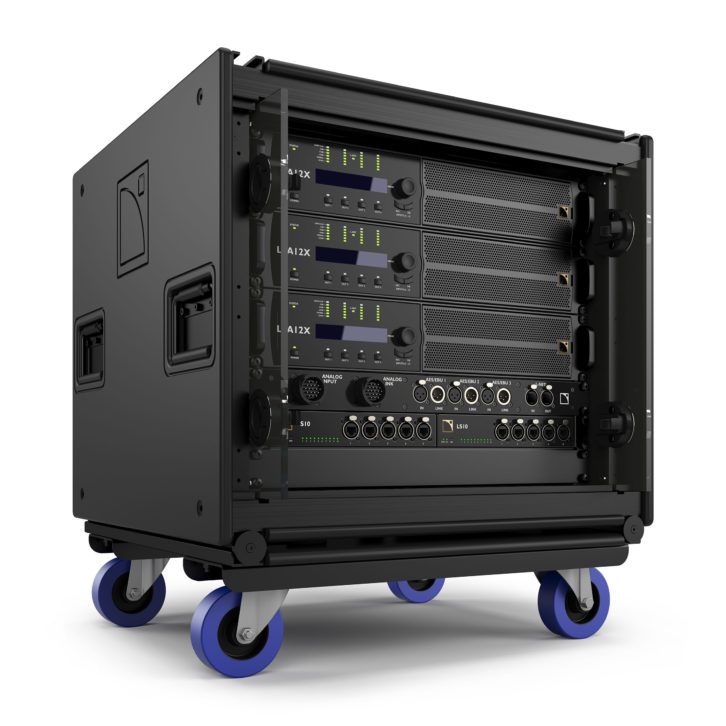 In January, L-Acoustics announced the LA-RAK II AVB flyable touring rack, comprising twelve channels of amplification in a 9U frame. Also included are three Milan-certified LA12X amplified controllers, two LS10 AVB switches, and power and signal distribution panels that are internally prewired to offer a plug-and-play, reliable and redundant networked audio. Two LS10 AVB switches in a 1U space within the rack allow for seamless dual network redundancy and a full AVB ecosystem from the P1 processor at FOH down to the Milan-certified amplified controllers. If any failure occurs on the primary audio network, the redundant AVB network automatically switches over with zero audio loss. Up to eight channels in one AVB stream can be passed over a single cable. As with its predecessors, LA-RAK II AVB is rugged, featuring a shock-absorbing inner frame, protective, and handling elements to facilitate transport. Compatible with any voltage standard, LA-RAK II AVB functions worldwide and facilitates tour logistics and cross-rental among L-Acoustics rental partners. LA-RAK II AVB is mechanically and electronically compatible with the legacy LA-RAK II and LA-RAK standards. An LARAK II AVB upgrade kit will be available for existing LA-RAK II owners for upgrade to AVB.
In January, L-Acoustics announced the LA-RAK II AVB flyable touring rack, comprising twelve channels of amplification in a 9U frame. Also included are three Milan-certified LA12X amplified controllers, two LS10 AVB switches, and power and signal distribution panels that are internally prewired to offer a plug-and-play, reliable and redundant networked audio. Two LS10 AVB switches in a 1U space within the rack allow for seamless dual network redundancy and a full AVB ecosystem from the P1 processor at FOH down to the Milan-certified amplified controllers. If any failure occurs on the primary audio network, the redundant AVB network automatically switches over with zero audio loss. Up to eight channels in one AVB stream can be passed over a single cable. As with its predecessors, LA-RAK II AVB is rugged, featuring a shock-absorbing inner frame, protective, and handling elements to facilitate transport. Compatible with any voltage standard, LA-RAK II AVB functions worldwide and facilitates tour logistics and cross-rental among L-Acoustics rental partners. LA-RAK II AVB is mechanically and electronically compatible with the legacy LA-RAK II and LA-RAK standards. An LARAK II AVB upgrade kit will be available for existing LA-RAK II owners for upgrade to AVB.
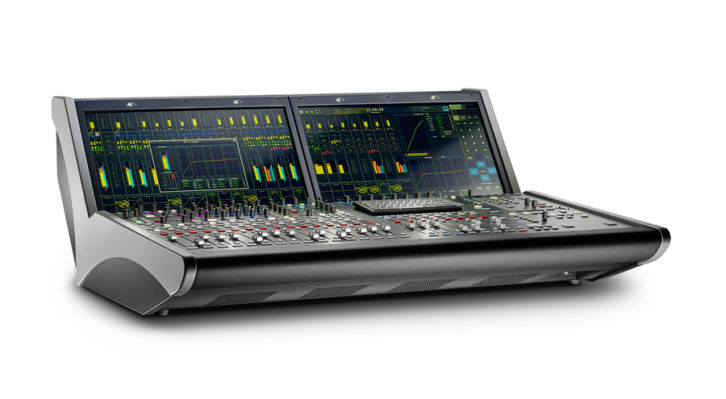 The Lawo mc²36 is natively equipped with RAVENNA/AES67 to integrate into IP infrastructure. With an internal 512×512 port audio matrix and integrated IO, it was designed to be a truly “universal” console, with its focus on space efficiency and ease-ofuse. Its 21.5-inch full HD touchscreens work with touch-sensitive color-illuminated rotary encoders to provide intuitive operation. In terms of connectivity, the console’s interfaces include 32 mic/line inputs, 32 line outputs, eight digital AES3 inputs, eight digital AES3 outputs, eight GPIO ports, one MADI (SFP) port, three RAVENNA/AES67 channels, and a headphone jack. In addition to the onboard I/O, a MADI tie-line connection and three RAVENNA/AES67 Audioover-IP ports provide future-proof connectivity for up to 384 external inputs and outputs, offering a total capacity of 496 physical inputs and outputs. It can ship pre-configured or custom-configured.
The Lawo mc²36 is natively equipped with RAVENNA/AES67 to integrate into IP infrastructure. With an internal 512×512 port audio matrix and integrated IO, it was designed to be a truly “universal” console, with its focus on space efficiency and ease-ofuse. Its 21.5-inch full HD touchscreens work with touch-sensitive color-illuminated rotary encoders to provide intuitive operation. In terms of connectivity, the console’s interfaces include 32 mic/line inputs, 32 line outputs, eight digital AES3 inputs, eight digital AES3 outputs, eight GPIO ports, one MADI (SFP) port, three RAVENNA/AES67 channels, and a headphone jack. In addition to the onboard I/O, a MADI tie-line connection and three RAVENNA/AES67 Audioover-IP ports provide future-proof connectivity for up to 384 external inputs and outputs, offering a total capacity of 496 physical inputs and outputs. It can ship pre-configured or custom-configured.
 Lectrosonics had versatility in mind when it developed the Aspen SPN2412, with its 24 inputs and 12 outputs, which can be expanded to many more. The Proportional Gain Algorithm allows it to work seamlessly with other sound gear, while data, audio, and control signals are carried through a single Cat-6 cable. Setup is aided by automatic master/slave detection and its automatic mixing parameters and presets are extensive including multizone mix minus configuration. The Phantom Mix mode lets the mixing come from multiple zones and fed back into only those zones that are selected for the feed. And with TCP/IP addressability for control through ethernet, it can be part of your network.
Lectrosonics had versatility in mind when it developed the Aspen SPN2412, with its 24 inputs and 12 outputs, which can be expanded to many more. The Proportional Gain Algorithm allows it to work seamlessly with other sound gear, while data, audio, and control signals are carried through a single Cat-6 cable. Setup is aided by automatic master/slave detection and its automatic mixing parameters and presets are extensive including multizone mix minus configuration. The Phantom Mix mode lets the mixing come from multiple zones and fed back into only those zones that are selected for the feed. And with TCP/IP addressability for control through ethernet, it can be part of your network.
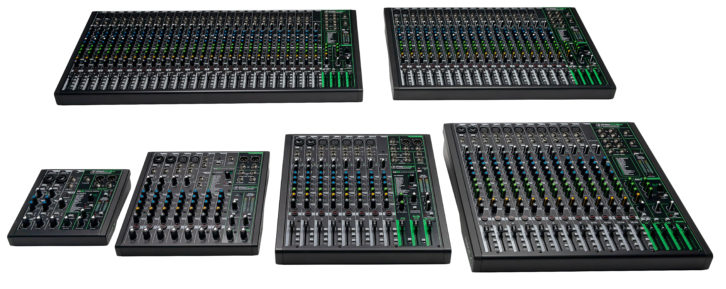 In January, Mackie announced a complete redesign of its analog mixer series, ProFXv3 Professional Effects Mixers with USB. The series now includes Mackie’s Onyx mic preamps, GigFX Effects Engine, 2×4 24-bit / 192kHz USB recording and a new look. ProFXv3 Series mixers carry Mackie’s flagship Onyx mic preamps, sample rates up to 192kHz, and up to 60dB of gain. The all-new GigFX HighResolution Effects Engine has 24 effects, including reverbs and delays. The built-in USB interface in ProFX mixers has been a popular feature in the series; the ProFXv3 offers a professional upgrade in recording quality. Mackie’s new partnership with Avid gives ProFXv3 users benefit and value. Pro Tools | First is now included, plus the exclusive Musician Collection bundle with 23 Avid plug-ins, including the 304C Compressor and 304E Equalizer. Users also get the Waveform OEM DAW software with their DAW Essentials Collection of 16 plug-ins.
In January, Mackie announced a complete redesign of its analog mixer series, ProFXv3 Professional Effects Mixers with USB. The series now includes Mackie’s Onyx mic preamps, GigFX Effects Engine, 2×4 24-bit / 192kHz USB recording and a new look. ProFXv3 Series mixers carry Mackie’s flagship Onyx mic preamps, sample rates up to 192kHz, and up to 60dB of gain. The all-new GigFX HighResolution Effects Engine has 24 effects, including reverbs and delays. The built-in USB interface in ProFX mixers has been a popular feature in the series; the ProFXv3 offers a professional upgrade in recording quality. Mackie’s new partnership with Avid gives ProFXv3 users benefit and value. Pro Tools | First is now included, plus the exclusive Musician Collection bundle with 23 Avid plug-ins, including the 304C Compressor and 304E Equalizer. Users also get the Waveform OEM DAW software with their DAW Essentials Collection of 16 plug-ins.
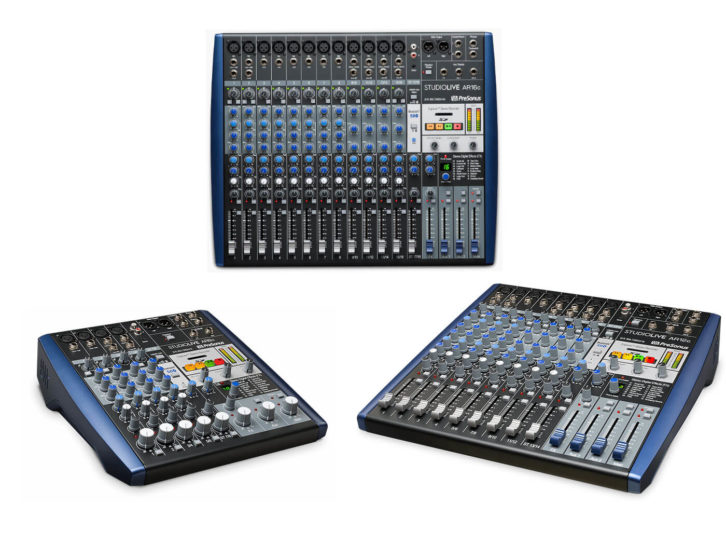 At NAMM 2020, PreSonus released three new mixers as part of its StudioLive ARc series. The new mixers combine a multichannel 24-bit/92kHz, USB-C compatible, USB 2.0 audio interface with an analogue mixer front-end. PreSonus’s goal with the hybrid mixer is to simplify the recording and mixing process within a single console. The StudioLive Arc Mixers have newly designed high-headroom analogue circuits, the company’s high-gain XMAX Class A mic preamps, plus Bluetooth connectivity. RCA inputs, and a 1/8inch stereo input. The onboard SD recorder allows recording without the need of a computer or DAW. StudioLive AR8c is the most compact model in the series, offering four XMAX mic preamps and six balanced line inputs for 8×4 recording and playback, with three-band EQ and an onboard effects processor. The effects include reverb, delay, chorus and more, with the option to record the main mix and capture the applied effects. StudioLive AR12c offers 8 XMAX mic preamps and 12 balanced line inputs for 14×4 recording and playback, plus the effects processing and features that are present on the AR8c. The StudioLive AR16c delivers 12 XMAX mic preamps and 16 balanced line inputs for 18×4 recording and playback. Each of the StudioLive Arc mixers come with PreSonus Capture live-recording software, and PreSonus’ Studio One DAW for both Mac and Windows. The Studio Magic Plug-in Suite, rounds out the all-in-one product.
At NAMM 2020, PreSonus released three new mixers as part of its StudioLive ARc series. The new mixers combine a multichannel 24-bit/92kHz, USB-C compatible, USB 2.0 audio interface with an analogue mixer front-end. PreSonus’s goal with the hybrid mixer is to simplify the recording and mixing process within a single console. The StudioLive Arc Mixers have newly designed high-headroom analogue circuits, the company’s high-gain XMAX Class A mic preamps, plus Bluetooth connectivity. RCA inputs, and a 1/8inch stereo input. The onboard SD recorder allows recording without the need of a computer or DAW. StudioLive AR8c is the most compact model in the series, offering four XMAX mic preamps and six balanced line inputs for 8×4 recording and playback, with three-band EQ and an onboard effects processor. The effects include reverb, delay, chorus and more, with the option to record the main mix and capture the applied effects. StudioLive AR12c offers 8 XMAX mic preamps and 12 balanced line inputs for 14×4 recording and playback, plus the effects processing and features that are present on the AR8c. The StudioLive AR16c delivers 12 XMAX mic preamps and 16 balanced line inputs for 18×4 recording and playback. Each of the StudioLive Arc mixers come with PreSonus Capture live-recording software, and PreSonus’ Studio One DAW for both Mac and Windows. The Studio Magic Plug-in Suite, rounds out the all-in-one product.
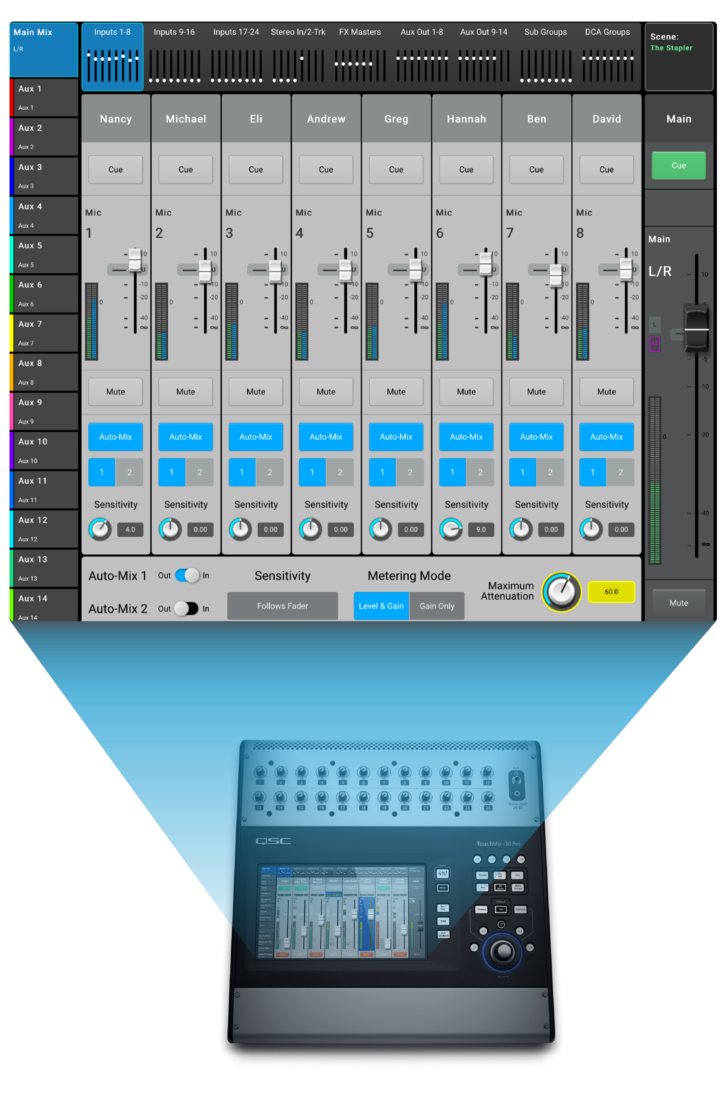 QSC added Automatic Microphone Mixing (Auto Mix) to its TouchMix-30 Pro digital mixer. Providing two independent processors available to all of the mixer’s 24 Mic/Line inputs, the easy-to-configure and use Auto Mix function delivers advanced gain sharing capabilities for applications such as conferences, presentations, panel discussions, and theatrical sound reinforcement. The TouchMix-30 Pro Automatic Microphone Mixing feature is a component of the latest firmware upgrade, Version 1.3, available as a free download at QSC.com.
QSC added Automatic Microphone Mixing (Auto Mix) to its TouchMix-30 Pro digital mixer. Providing two independent processors available to all of the mixer’s 24 Mic/Line inputs, the easy-to-configure and use Auto Mix function delivers advanced gain sharing capabilities for applications such as conferences, presentations, panel discussions, and theatrical sound reinforcement. The TouchMix-30 Pro Automatic Microphone Mixing feature is a component of the latest firmware upgrade, Version 1.3, available as a free download at QSC.com.
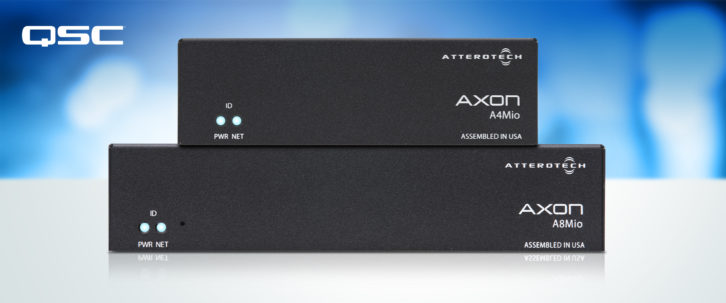 In April, QSC announces it is now shipping two new Axon AES67 networked audio I/O endpoints, from Attero Tech by QSC. The A8Mio (8-channel) and A4Mio (4-channel) are interoperable, flexible and cost-effective solutions that easily integrate analog mic/line sources into a wide range of network audio applications, including the Q-SYS Ecosystem. These Axon endpoints are Power over Ethernet (PoE) capable offering a single-cable installation in a 1/2-RU (A8Mio) or 1/3-RU (A4Mio) form factor with surfacemount or rack-mount capabilities.
In April, QSC announces it is now shipping two new Axon AES67 networked audio I/O endpoints, from Attero Tech by QSC. The A8Mio (8-channel) and A4Mio (4-channel) are interoperable, flexible and cost-effective solutions that easily integrate analog mic/line sources into a wide range of network audio applications, including the Q-SYS Ecosystem. These Axon endpoints are Power over Ethernet (PoE) capable offering a single-cable installation in a 1/2-RU (A8Mio) or 1/3-RU (A4Mio) form factor with surfacemount or rack-mount capabilities.
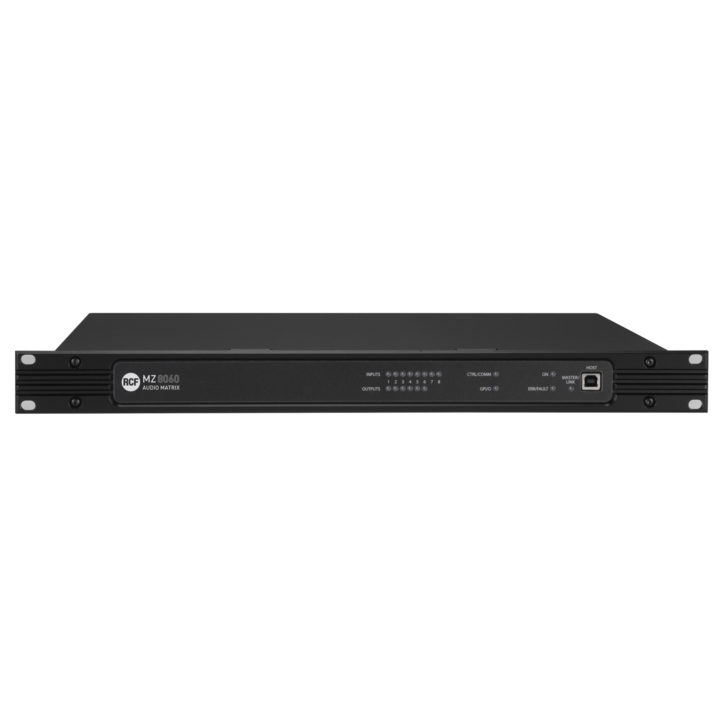 The RCF MZ 8060 is a versatile 8×6 digital audio matrix mixer built on the foundation of RCF’s RDNet DSP platform. RDNet is a proprietary protocol for RCF loudspeaker products that provides dedicated networking software that makes is possible to control and monitor all system components and parameters. The DSP allows for configurable system programming including room combining, automatic level control, along with all audio input and output criteria including EQs, gates, compressors, limiters, delays, priorities, and levels. The MX8060 features eight universal mic/ line inputs with six balanced outputs along with 10 programmable logic inputs and six programmable logic outputs. It features eights universal mic/ line inputs with 48V phantom power and full audio processing, six hi-level routable balanced outputs with full audio processing, 10 programmable logic inputs (GPI), and six programmable logic outputs (GPO).
The RCF MZ 8060 is a versatile 8×6 digital audio matrix mixer built on the foundation of RCF’s RDNet DSP platform. RDNet is a proprietary protocol for RCF loudspeaker products that provides dedicated networking software that makes is possible to control and monitor all system components and parameters. The DSP allows for configurable system programming including room combining, automatic level control, along with all audio input and output criteria including EQs, gates, compressors, limiters, delays, priorities, and levels. The MX8060 features eight universal mic/ line inputs with six balanced outputs along with 10 programmable logic inputs and six programmable logic outputs. It features eights universal mic/ line inputs with 48V phantom power and full audio processing, six hi-level routable balanced outputs with full audio processing, 10 programmable logic inputs (GPI), and six programmable logic outputs (GPO).
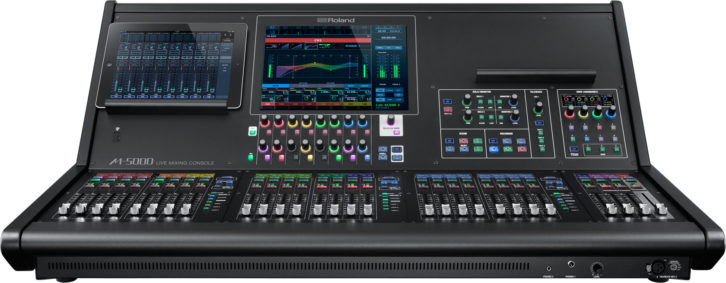 The M-5000 Series mixing consoles from Roland apply its OHRCA (Open High Resolution Configurable Architecture) to provide 128 freely definable audio paths. The mixers have expansion modules for Dante, MADI, Waves Soundgrid, REAC, XI-SDI, XI- SFP, and XI-DVI. Its patchbays can accommodate hundreds of input/output channels enabling any input to be routed to a range of outputs without using a mixing channel. The M-5000 has 24 plus 4 faders while the slightly smaller M-5000C uses 16 plus 4 faders. The operation is focused on a bright 12in. touchscreen with 16 encoders having rings that change color according to their assigned functions.
The M-5000 Series mixing consoles from Roland apply its OHRCA (Open High Resolution Configurable Architecture) to provide 128 freely definable audio paths. The mixers have expansion modules for Dante, MADI, Waves Soundgrid, REAC, XI-SDI, XI- SFP, and XI-DVI. Its patchbays can accommodate hundreds of input/output channels enabling any input to be routed to a range of outputs without using a mixing channel. The M-5000 has 24 plus 4 faders while the slightly smaller M-5000C uses 16 plus 4 faders. The operation is focused on a bright 12in. touchscreen with 16 encoders having rings that change color according to their assigned functions.
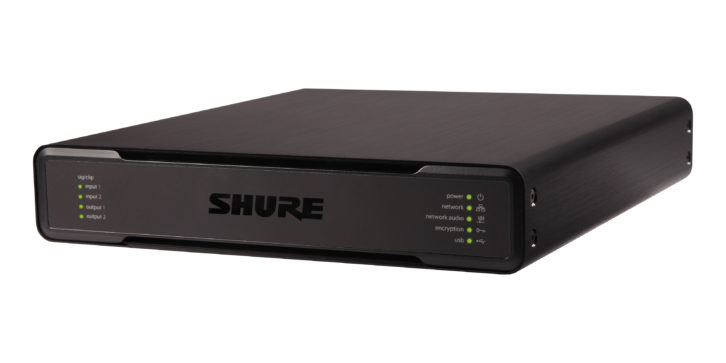 The Shure IntelliMix P300 conferencing connects up to 10 Dante audio inputs, two analog inputs, a USB soft codec, and mobile device. Each input channel can be auto-mixed and provides acoustic echo cancellation, noise reduction, automatic gain control, matrix mixing, delay, compressor, and PEQ. An additional 3.5mm connection enables attendees to join by tablet or phone, and all this fits into a half-rack space package. It connects to room systems through two input and two output terminal blocks while its ethernet connection can use PoE to eliminate a separate power supply. Additionally, a predefined matrix and presets can simplify the setup process.
The Shure IntelliMix P300 conferencing connects up to 10 Dante audio inputs, two analog inputs, a USB soft codec, and mobile device. Each input channel can be auto-mixed and provides acoustic echo cancellation, noise reduction, automatic gain control, matrix mixing, delay, compressor, and PEQ. An additional 3.5mm connection enables attendees to join by tablet or phone, and all this fits into a half-rack space package. It connects to room systems through two input and two output terminal blocks while its ethernet connection can use PoE to eliminate a separate power supply. Additionally, a predefined matrix and presets can simplify the setup process.
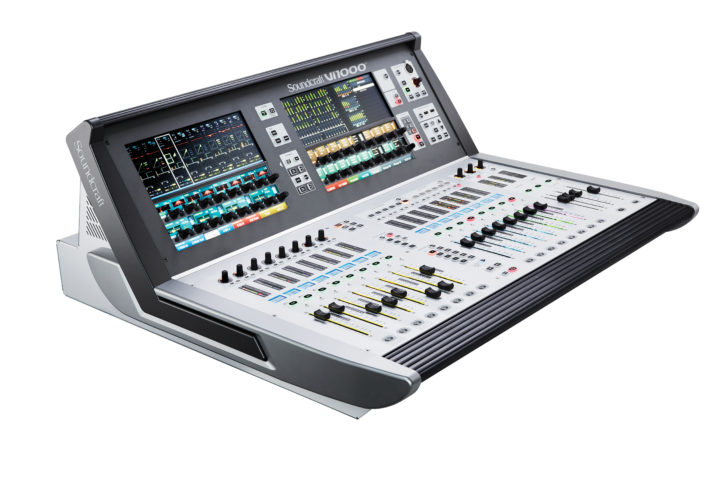
Soundcraft by HARMAN offers the Vi1000 digital mixing console, a 34in. x 32in. compliment to its two larger siblings, the Vi2000 and 3000. The Vi1000 employs Soundcraft’s Vistonics II channel strip user interface, as well as SpiderCore, a built-in DSP and I/O engine based on STUDER technology, offering 40-bit floating point processing. The Vi1000 features an additional remote-control surface for any of the larger consoles in the range, using their Mirroring feature. The Vi1000 comes with rear panel local I/O featuring 16 HQ mic/line inputs, 16 line outputs, and two 64-channel expansion slots that allow up to two MADIbased Stageboxes to be connected, or alternatively the slots provide access to an extensive range of D21m I/O option cards, that address all industry standard audio formats. Four channels of AES/EBU I/O plus USB and MIDI connections complete the back panel. The total I/O count of the console is 212 in x 212 out.
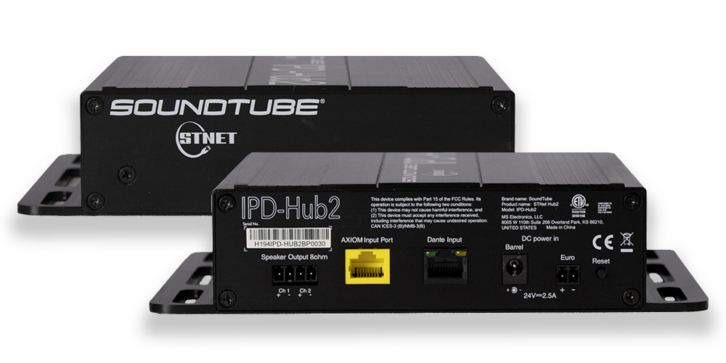 The SoundTube IPD Hub 2 amplifier from MSE Audio is a twochannel Dante amp with DSP built-in, designed for small- to medium-sized applications. The amp is AES67-compatible and powered by PoE, PoE+ or 40W PoE. It includes an RJ45 Ethernet connection and can be used with Radio Design Labs Format A (RDL) or Attero Tech Axiom line level, mic level, balanced XLR or Bluetooth input devices — stereo or mono, virtually any input. Integrators can create a complete Dante-enabled audio system with SoundTube RVC-1 controls without using a traditional DSP. Using a decentralized DSP amplifier in each zone rather than a centralized DSP greatly reduces hardware costs making an IPD-HUB 2 networked audio system about the same price as a conventional 70/100V distributed audio system.The IPD HUB 2 Amplifier can be linked together to distribute audio over large spaces or set up to operate in up to eight zones.
The SoundTube IPD Hub 2 amplifier from MSE Audio is a twochannel Dante amp with DSP built-in, designed for small- to medium-sized applications. The amp is AES67-compatible and powered by PoE, PoE+ or 40W PoE. It includes an RJ45 Ethernet connection and can be used with Radio Design Labs Format A (RDL) or Attero Tech Axiom line level, mic level, balanced XLR or Bluetooth input devices — stereo or mono, virtually any input. Integrators can create a complete Dante-enabled audio system with SoundTube RVC-1 controls without using a traditional DSP. Using a decentralized DSP amplifier in each zone rather than a centralized DSP greatly reduces hardware costs making an IPD-HUB 2 networked audio system about the same price as a conventional 70/100V distributed audio system.The IPD HUB 2 Amplifier can be linked together to distribute audio over large spaces or set up to operate in up to eight zones.
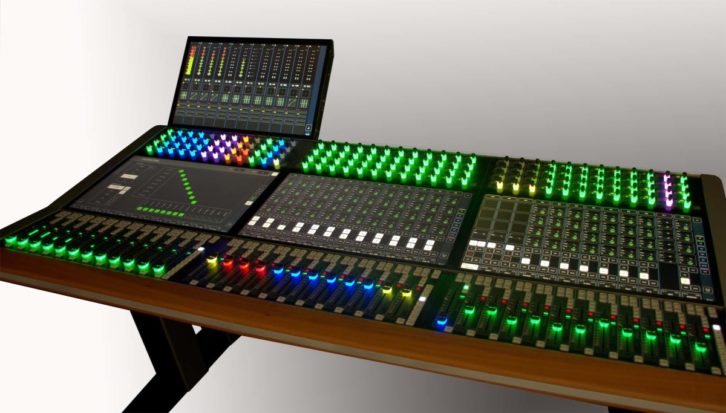 Stage Tec’s IP-based mixing console AVATUS is a theatre console with detachable screens. In many theaters, due to structural conditions, control rooms are built such that the sound engineers cannot see over their mixing console to the stage. AVATUS offers a solution to this problem. The theatre version of AVATUS is designed so that the upper screens are removable. Since the IP console is connected via standard TCP/IP interfaces, each module has its own IP address. This enables the screens to be installed anywhere within the NEXUS network. AVATUS IPbased connections offer new possibilities for development of infrastructures. The AVATUS audio console does not have a center section and will consist of only three different modules. The console will be available in sizes between 12 and 96 faders.
Stage Tec’s IP-based mixing console AVATUS is a theatre console with detachable screens. In many theaters, due to structural conditions, control rooms are built such that the sound engineers cannot see over their mixing console to the stage. AVATUS offers a solution to this problem. The theatre version of AVATUS is designed so that the upper screens are removable. Since the IP console is connected via standard TCP/IP interfaces, each module has its own IP address. This enables the screens to be installed anywhere within the NEXUS network. AVATUS IPbased connections offer new possibilities for development of infrastructures. The AVATUS audio console does not have a center section and will consist of only three different modules. The console will be available in sizes between 12 and 96 faders.
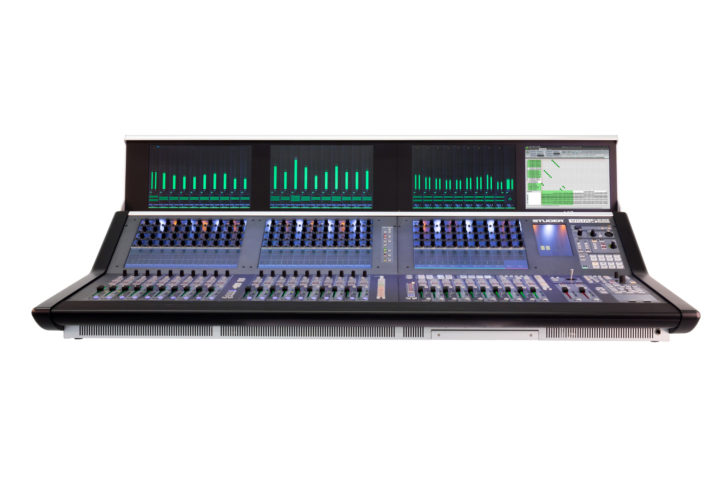 Harman’s Studer Vista 5 Black Edition console is a “budget friendly” addition to its Vista 5 line. The desk is designed to be a scalable mixing system with full processing redundancy. Based on the Vista 5 M3 mixing console, the new Vista 5 Black Edition features the Studer Infinity Core processing engine. The Studer Vista 5 Black Edition is available in 22-, 32-, and 44-fader sizes, and supports an optional TFT meter bridge. The console’s features include Studer’s Vistronics interface and FaderGlow technology, as well as the Infinity Core’s advanced capabilities such as Dynamic EQ plug-ins and full Core redundancy with up to 1,000 MEQs (Mono Equivalent Channels). The Vista 5 Black Edition supports any of Studer’s range of Infinity Core products, as well as the Studer Infinity Core Commercial off the Shelf (COTS) solution. This IT-based solution allows customers to run Studer’s real-time audio processing on their own server hardware by adding a standard PCIe Infinity CoreLink card.
Harman’s Studer Vista 5 Black Edition console is a “budget friendly” addition to its Vista 5 line. The desk is designed to be a scalable mixing system with full processing redundancy. Based on the Vista 5 M3 mixing console, the new Vista 5 Black Edition features the Studer Infinity Core processing engine. The Studer Vista 5 Black Edition is available in 22-, 32-, and 44-fader sizes, and supports an optional TFT meter bridge. The console’s features include Studer’s Vistronics interface and FaderGlow technology, as well as the Infinity Core’s advanced capabilities such as Dynamic EQ plug-ins and full Core redundancy with up to 1,000 MEQs (Mono Equivalent Channels). The Vista 5 Black Edition supports any of Studer’s range of Infinity Core products, as well as the Studer Infinity Core Commercial off the Shelf (COTS) solution. This IT-based solution allows customers to run Studer’s real-time audio processing on their own server hardware by adding a standard PCIe Infinity CoreLink card.
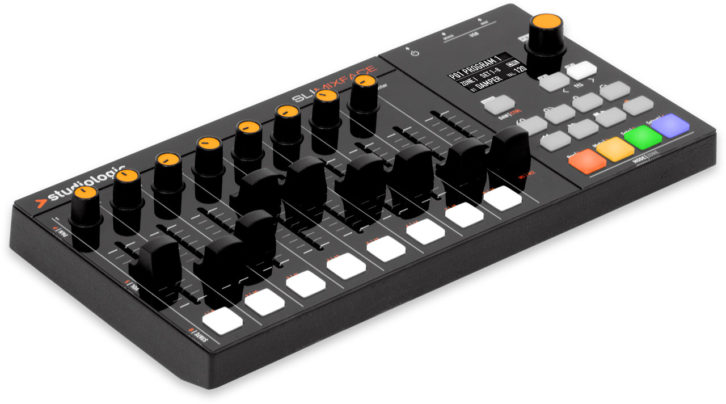 The Studiologic SL MIXFACE is a complete MIDI and DAW Controller device, fully programmable for software and hardware instruments. Designed for mobility, the unit can be battery powered or bus-powered via USB. The SL MIXFACE is able to host any compatible keyboard to transform it into a full four zones MIDI controller and its connectivity ports enable it to communicate with the computer and other devices by using Bluetooth and USB simultaneously. The surface of the SL MIXFACE features nine faders, eight tracks, and one master, with dedicated, pertrack knobs and buttons. The usability of the controller is further enhanced by the DAW/ CTRL button, which allows users to switch the control from the DAW environment to their instrument and vice versa, all reflected on the onboard OLED screen.
The Studiologic SL MIXFACE is a complete MIDI and DAW Controller device, fully programmable for software and hardware instruments. Designed for mobility, the unit can be battery powered or bus-powered via USB. The SL MIXFACE is able to host any compatible keyboard to transform it into a full four zones MIDI controller and its connectivity ports enable it to communicate with the computer and other devices by using Bluetooth and USB simultaneously. The surface of the SL MIXFACE features nine faders, eight tracks, and one master, with dedicated, pertrack knobs and buttons. The usability of the controller is further enhanced by the DAW/ CTRL button, which allows users to switch the control from the DAW environment to their instrument and vice versa, all reflected on the onboard OLED screen.
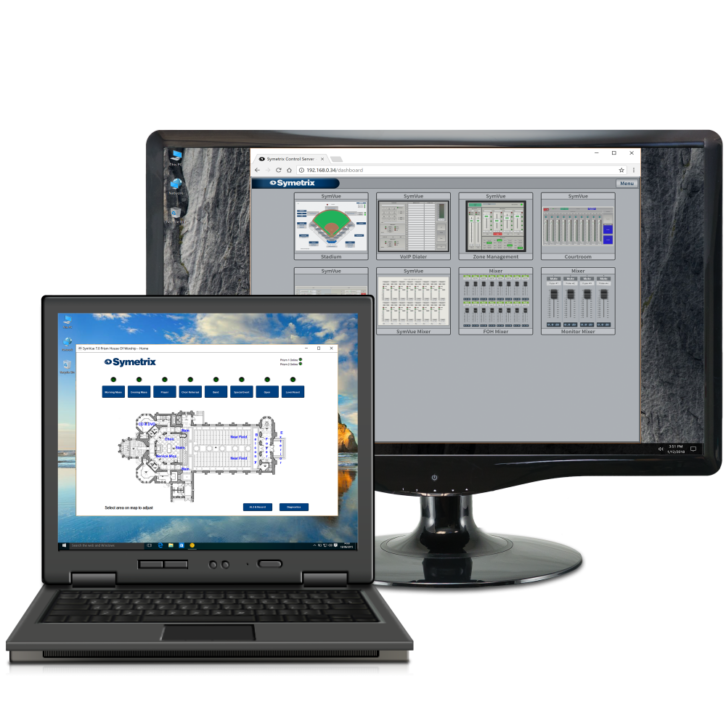 The Symetrix SymVue software, for its Control Server hardware, is a server-based application designed to control Symetrix DSPs. SymVue enables custom GUIs authored using Symetrix’ Composer running on the Symetrix Control Server hardware. Application-specific control screens can be designed and tested in minutes, without writing any code. With SymVue deployed on Symetrix Control Server hardware, Symetrix DSPs can respond to commands from any browser-enabled device — laptops, desktops, tablets, and mobile phones. SymVue’s WYSIWYG designs render in all popular web browsers and adapt to screens of different sizes, resolutions, and orientations. Parameter changes remain in sync across all networked devices including Composer, ARC Wall Panels and ARC-WEB, third-party controllers, and SymVue clients on Windows PCs.
The Symetrix SymVue software, for its Control Server hardware, is a server-based application designed to control Symetrix DSPs. SymVue enables custom GUIs authored using Symetrix’ Composer running on the Symetrix Control Server hardware. Application-specific control screens can be designed and tested in minutes, without writing any code. With SymVue deployed on Symetrix Control Server hardware, Symetrix DSPs can respond to commands from any browser-enabled device — laptops, desktops, tablets, and mobile phones. SymVue’s WYSIWYG designs render in all popular web browsers and adapt to screens of different sizes, resolutions, and orientations. Parameter changes remain in sync across all networked devices including Composer, ARC Wall Panels and ARC-WEB, third-party controllers, and SymVue clients on Windows PCs.
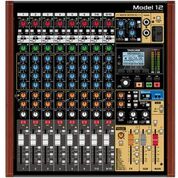 TASCAM’s Model 12 is a downsized counterpart to last year’s Model 16 and 24 devices. It is a 10-input mixer with integrated 12-track digital recorder and 12-in, 10-out audio interface. There are six mono channels, each equipped with one of TASCAM’s UltraHDDA preamps, plus two stereo channels, the latter of which includes both mini-jack and Bluetooth inputs for the connection of smartphones or tablets. Each channel is equipped with a three-band EQ, low-cut filter and one-knob compressor. There is also a digital effects processor offering a range of reverb, delay and modulation effects, plus two aux outputs with individual send level controls. The Model 12 can capture 12 tracks – the ten channels plus stereo main out – in WAV format up-to 48kHz/24-bit, directly to SD, SDHC and SDXC cards. The mixer interface can also be used as a basic DAW controller too, using the MCU/HUI protocol. Additional features include MIDI in and out, a footswitch input for triggering the recorder, a stereo sub mix output, and two headphone outs with individual level controls.
TASCAM’s Model 12 is a downsized counterpart to last year’s Model 16 and 24 devices. It is a 10-input mixer with integrated 12-track digital recorder and 12-in, 10-out audio interface. There are six mono channels, each equipped with one of TASCAM’s UltraHDDA preamps, plus two stereo channels, the latter of which includes both mini-jack and Bluetooth inputs for the connection of smartphones or tablets. Each channel is equipped with a three-band EQ, low-cut filter and one-knob compressor. There is also a digital effects processor offering a range of reverb, delay and modulation effects, plus two aux outputs with individual send level controls. The Model 12 can capture 12 tracks – the ten channels plus stereo main out – in WAV format up-to 48kHz/24-bit, directly to SD, SDHC and SDXC cards. The mixer interface can also be used as a basic DAW controller too, using the MCU/HUI protocol. Additional features include MIDI in and out, a footswitch input for triggering the recorder, a stereo sub mix output, and two headphone outs with individual level controls.
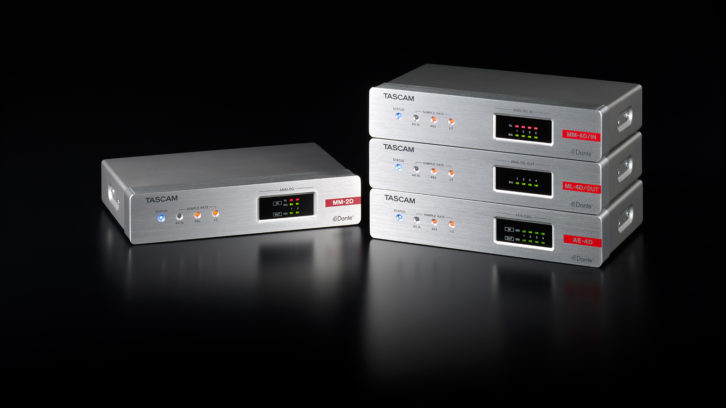 TASCAM’s Dante Compact Processor series comprises seven half-rack Dante audio converters featuring onboard digital matrix mixers with signal processing. These Dante-enabled input/output endpoints deliver up to 24-bit, 96 kHz audio conversion. Dante Compact Processors can be freely combined to create custom systems and are easily installed under desks or on walls with the included surface rack-mount angles or rack-mounted with the optional AK-RS1 rack shelf. All models offer the flexible routing of Audinate’s Dante controller, and are compatible with Dante AES67 mode and Dante Domain Manager. They offer remote control via GPI, Dante, and either of two free TASCAM control software applications, one for integrators and one for end users.
TASCAM’s Dante Compact Processor series comprises seven half-rack Dante audio converters featuring onboard digital matrix mixers with signal processing. These Dante-enabled input/output endpoints deliver up to 24-bit, 96 kHz audio conversion. Dante Compact Processors can be freely combined to create custom systems and are easily installed under desks or on walls with the included surface rack-mount angles or rack-mounted with the optional AK-RS1 rack shelf. All models offer the flexible routing of Audinate’s Dante controller, and are compatible with Dante AES67 mode and Dante Domain Manager. They offer remote control via GPI, Dante, and either of two free TASCAM control software applications, one for integrators and one for end users.
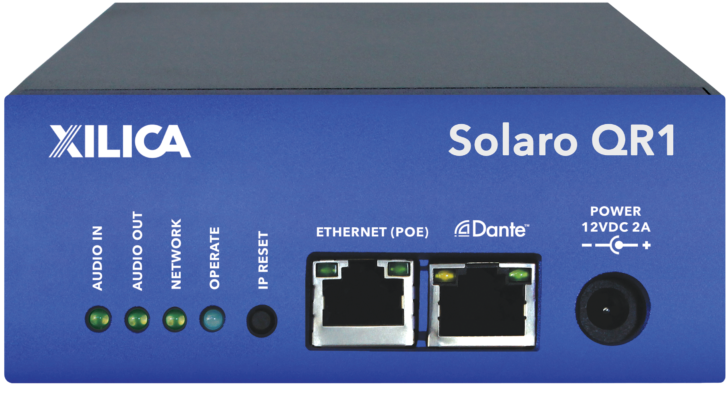 The Xilica Solaro QR1 is a quarter-rack Linux-based DSP processor has eight modular card slots that accept 2-channel audio input and output cards and 4-channel GPIO cards selectable as input or output. The ability to use any card type, in any combination, in any card slot maximizes I/O flexibility, and allows designers to specifically customize I/O without waste. A 4×4 Dante card is built-in. Supported by Xilica’s drag-and-drop Designer, it is compatible with various Xilica control interfaces as well as any third-party control system. External power supply included; also PoE. Optional AEC mic inputs up to 8-channels@250ms and 16channels@100ms.
The Xilica Solaro QR1 is a quarter-rack Linux-based DSP processor has eight modular card slots that accept 2-channel audio input and output cards and 4-channel GPIO cards selectable as input or output. The ability to use any card type, in any combination, in any card slot maximizes I/O flexibility, and allows designers to specifically customize I/O without waste. A 4×4 Dante card is built-in. Supported by Xilica’s drag-and-drop Designer, it is compatible with various Xilica control interfaces as well as any third-party control system. External power supply included; also PoE. Optional AEC mic inputs up to 8-channels@250ms and 16channels@100ms.
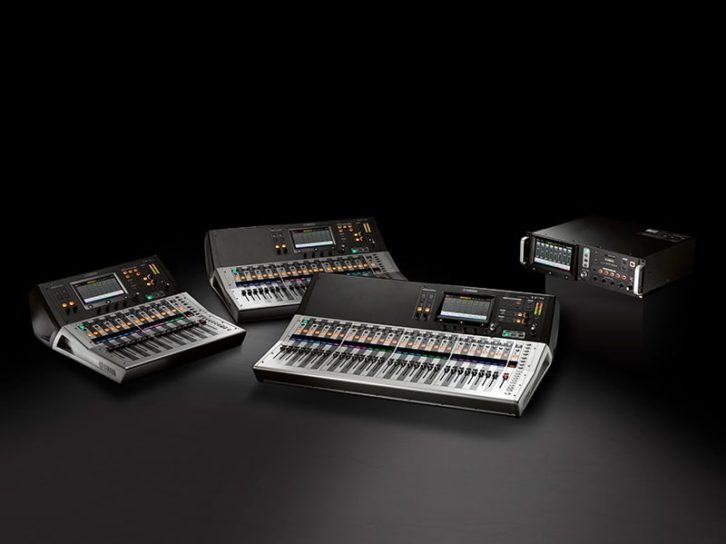 The Yamaha TF Series Digital Mixers with touch-panel operation gained enhanced control and versatility with firmware update version 4.0. Firmware update V4.0 adds a Selected Channel View that provides access to the main parameters for the currently selected input channel in a single display. Combined with the mixer’s Touch & Turn Knob, this new view provides even more intuitive, efficient operation. V4.0 also adds a scene fade time function that offers new flexibility for scene management, particularly in theatrical applications. Support for DZR-D and DXSXLF-D Series speakers has been expanded with speaker amp mute control directly from the mixer display. In January, Yamaha also released V5.5 firmware (now V5.51) for the CL/QL series digital mixers. This firmware supports ProVisionaire Control/Touch, the latest Version 3.6.0 enabling complete control over the entire network chain, from mixers through to amplifiers (including Yamaha’s PC Series and the NEXO NXAMP4X4MK2), processors and speakers.
The Yamaha TF Series Digital Mixers with touch-panel operation gained enhanced control and versatility with firmware update version 4.0. Firmware update V4.0 adds a Selected Channel View that provides access to the main parameters for the currently selected input channel in a single display. Combined with the mixer’s Touch & Turn Knob, this new view provides even more intuitive, efficient operation. V4.0 also adds a scene fade time function that offers new flexibility for scene management, particularly in theatrical applications. Support for DZR-D and DXSXLF-D Series speakers has been expanded with speaker amp mute control directly from the mixer display. In January, Yamaha also released V5.5 firmware (now V5.51) for the CL/QL series digital mixers. This firmware supports ProVisionaire Control/Touch, the latest Version 3.6.0 enabling complete control over the entire network chain, from mixers through to amplifiers (including Yamaha’s PC Series and the NEXO NXAMP4X4MK2), processors and speakers.


